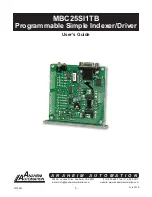
August 2012
L010440
12
Functions
Hard Limit Switches:
When a hard limit switch is encountered, the pulses will stop. Hard limits
are intended as an emergency stop for your system.
Soft Limit Switches:
These switches cause the indexer to ramp down to the base speed and
finish the index, unless encountering a hard limit switch.
Profile Inputs:
These inputs are used to select and begin the specified motion profile. Only 1
input should be activated at a time.
Motion Profiles:
The indexer will accept two different speed or motion profiles. Each profile has
its own programmable Accel/Decel, Base speed and distance value. These values are stored in
EEProm for standalone use and must be programmed before the pulse generator is ran.
Acceleration/Deceleration:
The acceleration and deceleration are by default the same value.
This function controls the time that the motor will take to move from base speed to max speed.
The higher the value, the slower the motor will accelerate. The same principle applies for the
deceleration which is controlling the time it takes to go from maximum speed to base speed.
The higher the value, the slower the pulses will decelerate. The different accel/decel profiles are
stored in EEprom for standalone use. (Range: 100 to 9,999,999)
Base Speed:
The base speed is the speed at which motion starts and stops. It is entered directly
as the number of steps per second. This speed must always be less than the max speed. The
different base profiles are stored in EEprom for standalone use. (Range:1 to 5000)
Max Speed:
The max speed is the top speed the user wants the pulses to run at. This speed must
always be equal or greater than the base speed. It is entered directly as the number of steps/
second. The different max profiles are stored in EEprom for standalone use. (Range:1 to 50,000)
Index Number:
The index number is the number of steps that the motor will take when the motion
profile starts. It is entered directly as the number of steps to take. The different index profiles
are stored in EEprom for standalone use. (Range: 0 to 8,388,607)
Direction Input:
If this input is open then the unit will be running in the clockwise direction. If
this input is active then the unit will be running in the counterclockwise direction. This pin can
be overridden by the programmable software direction. It will activate the direction output when
the pin is changed. This means, that if you start the profile from the software, the unit will look
at the software direction. If you start the indexer from the inputs, then the unit will look at the
direction input.
Busy Input:
This output will be pulled low when the indexer is operating. It is an open drain
output so when the indexer is not running the pin is open.
Clock Output:
The external clock is the output of the internal pulse that can be used to daisy
chain other step motor drivers together. This is an open collector output that is capable of sink
-
ing 10mA.
July 2018








































